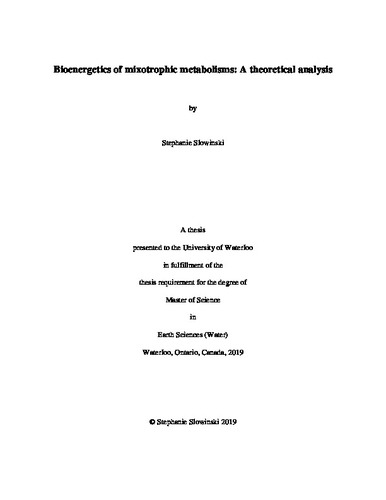| dc.description.abstract | Many biogeochemical reactions controlling surface water and groundwater quality, as well as greenhouse gas emissions and carbon turnover rates, are catalyzed by microorganisms. Representing the thermodynamic (or bioenergetic) constraints on the reduction-oxidation reactions carried out by microorganisms in the subsurface is essential to understand and predict how microbial activity affects the environmental fate and transport of chemicals. While organic compounds are often considered to be the primary electron donors (EDs) in the subsurface, many microorganisms use inorganic EDs and are capable of autotrophic carbon fixation. Furthermore, many microorganisms and communities are likely capable of mixotrophy, switching between heterotrophic and autotrophic metabolisms according to the environmental conditions and energetic substrates available to them. The potential for switching between metabolisms has important implications for representing microbially-mediated reaction kinetics in environmental models. In this thesis, I integrate existing bioenergetic and kinetic formulations into a general modeling framework that accounts for the switching between metabolisms driven by either an organic ED, an inorganic ED, or both.
In Chapter 2, I introduce a conceptual model for mixotrophic growth. The conceptual model combines the carbon and energy balances of a cell by accounting for the allocation of an organic ED between incorporation into biomass growth and the generation of energy in catabolism. I select experimental datasets from the literature in which mixotrophic growth of pure culture organisms is assessed in chemostats. These experiments employ biochemical methods that allow one to estimate the contributions of the possible end-member metabolisms under variable supply rates of organic and inorganic EDs. Using the conceptual model, I develop a quantitative modeling framework that explicitly accounts for the substrate utilization kinetics and the energetics of the catabolic and anabolic reactions. I then compare the model predictions to the experimental data.
While in Chapter 2 datasets collected in controlled laboratory settings are considered, in Chapter 3 I apply my modeling framework for mixotrophic growth to a lake sediment geochemistry dataset. I focus on the activity of a nitrate reducing, acetate and iron(II) oxidizing mixotrophic microbial community in the suboxic zone of the lake sediment. I demonstrate the application of the modeling framework to this natural system, based on the reported concentration profiles of the relevant EDs (i.e., acetate and iron(II)), electron acceptors (EAs) (i.e., nitrate), and other reactants and products to calculate the depth distributions of the energetic and kinetic constraints in the model calculations. The predicted fractions of the metabolic end-members are in general agreement with the relative distributions of the different microbial functional groups reported in the original study. I also assess the sensitivity of the model’s predictions on the kinetic parameter values used to simulate the net utilization rates of the two EDs. The results of the analysis provide new insights into the role of mixotrophy in the coupled cycling of nitrogen, iron(II), and dissolved inorganic carbon in the nitrate-reducing zone of lake sediments.
The conceptual model and modeling framework presented in this thesis can be used to account for mixotrophic activity in environmental reactive transport models. That is, in the future, this modeling framework could be incorporated into models that simulate the interactions of mixotrophy with other geochemical, geomicrobial, and transport processes. The work presented in this thesis is thus a valuable step towards building realistic theoretical representations of microbial activity in earth’s near surface environments. | en |

